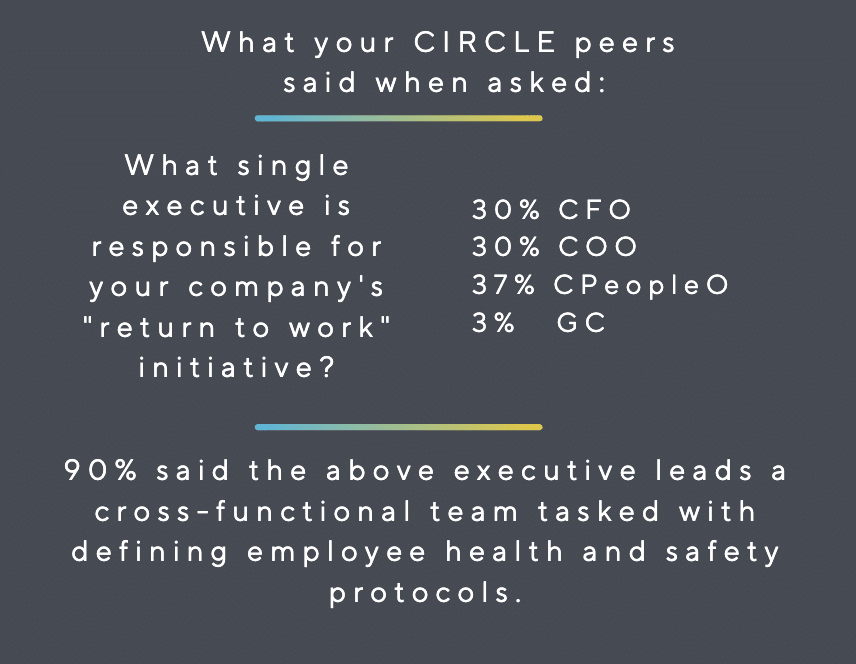Trending
Top CFO Tactics for Reducing Software Spend & Consolidating Systems
/in I'm Looking for Strategic Planning Tips, Software Stack for Growth Companies, Systems & Processes, Trending, Featured on Home/by Matt McCue4 Considerations To Craft Your Company’s Equity Strategy
/in I Need to Retain my Top Performers, Secondary Liquidity, Developing Your Team, Talent, Trending, Equity & Compensation, Featured on Home/by Matt McCueAdvancing Your Influence: Strategies for CFOs
/in CFO Leadership, Leadership & Vision, Developing Your Team, Talent, Trending, Featured on Home/by Matt McCueShare this entry

Health and Safety Protocols for Returning to On-Site Work
The Circle gathered recently with a broad group of leaders to discuss the timely topic of protecting the health and safety of their employees as they make their way back to the office. Members of The Circle and those they lead have been dealing directly with the topic since the onset of shelter-in-place.
-
The Chief Medical Officer (and infectious disease physician) of Dignity Health who has kept an entire hospital system running and delivering patient care
-
The VP of Manufacturing of Sun Basket who has had facilities filled with employees preparing and delivering food to doorsteps
-
An Occupational and environmental consultant of Colden who has been guiding companies on everything from the physical facility to workstation ergonomics
-
Attorneys in employment liability and real estate from Goodwin who are savvy at mitigating a company’s risk as well as enlisting assistance from landlords
Here were the key takeaways from the Circle|Call:
Planning the Return
Have a Plan | Alignment + Communication + Training
Two of our very important peers have been open with their perspective from the onset of shelter-in-place, and they recommend formulating the details of your return plan well before it’s time to go back to the office. And although the plan will likely change as time passes and new guidelines come in, our peers agree that planning early and thoroughly is an integral move in this scenario.
Your “return plan” should consider the following:
- Get your leadership and management team together to start planning, in order to ensure that everyone is aligned and onboard. Make sure that leadership is thoroughly trained on the plan and that they are able to help train others.
- Break out the necessary tasks needed and assign them to the team. This includes:
> Deciding who comes back to the office, who doesn’t and why
> Defining your social distancing protocols
> Formulating an office separation plan
> Instituting a procedure for positive cases and defining direct contact - Research your role in administering the plan
- Communicate the plan clearly and confidently to the team
“Making sure the plan is in front of the team before it [COVID-19] actually hits, then they feel comfortable and confident in your ability to keep them safe. So they start trusting you and they don’t start double guessing everything as soon as something unfortunate happens.”
Which agency or level of government do you follow?
Governors are authorizing certain industries to reopen and issuing templates/guidance on what must be addressed in reopening plans. While these vary by state, below are examples of common guidelines and mandates. And beyond these measures, you must comply with local county and city mandates. The CDC is a useful resource for this information (as is OSHA).
- Examine your physical space to ensure that appropriate changes are implemented
- Employees who are symptomatic or have been exposed must be required to remain home
- Employees must be trained on social distance and hygiene (EVS)
- Most states are highly encouraging contact tracing
- Most states are requiring a staged return to work
- Employers are encouraged to telework whenever possible
Beyond these measures, you must comply with local county and city mandates. The CDC is a useful resource for this information (as is OSHA).
“You need to listen to your local authority. Federal and state systems are meant to support your local and guide your local health department. The CDC is issuing guidance. They’re issuing recommendations. They’re putting out tool kits and their guidance somewhat guides the local health department. But really the orders and the mandates are coming from your local health department”
What are your legal obligations?
The best way to minimize your company’s liability is to adhere to CDC, state, and local guidelines and mandates. These are unique to your locality and here are some useful resources for understanding those guidelines. If you do not strictly adhere you open yourself up to scrutiny from local authorities and your own employees, as well as potential legal action.
Failing to comply with local mandates and CDC guidelines is not only a legal hazard, but also a serious ethical concern. Show your employees and business partners that you respect their health and safety. Make your best effort in ensuring compliance in your sphere of influence.
“So in the event that an employee contracted COVID-19 at work, yes, if they could prove that, and the causation element is tough, but they would be eligible for workers’ comp. But they would not be able to bring a claim against the employer.”
If you aren’t already having conversations with your landlords about rent relief, you’ll want to start soon. A crucial point of conversation will focus around the common areas of your office space and defining whose responsibility these spaces are. Note that landlords are currently trying to resist taking ownership of checkpoints in common areas, like lobbies.
What the experts are seeing “big” landlords doing is encouraging their tenants to self-report symptoms through a questionnaire, otherwise self-certifying that they can come to work, or having a thermal test when they get to the front door. That said, some states have issued specific orders and mandates regarding landlords and their property’s common spaces, including lobbies, elevators, or any other space that is traveled through to get to an office.
“There are about seven or eight industries that have specific mandates [from the CDC]. Tech is not one. Traditional office business is not one, but if you were in anything that’s very public-facing, there are specific mandates about signages and things like that you must post. So you really, then, have to go to the CDC website.”
But locally, it’s different “in Massachusetts, there is a specific industry protocol for offices, office space. And employers are required to make sure that their employees wear face masks when they’re outside their individual office.”
Note that you are not legally obligated to take measures related to your employees’ transportation to and from the office – though you may consider initiatives to reduce the risk that employees contract the virus on their commute (e.g. allow off-peak hour commutes, pay for parking, reimburse Ubers).
“I think it’s the employee’s responsibility. It is their responsibility to get to work. The company is not obligated [to get them to work].”
Preparing the Office
What are best practices for implementing social distance policies and workplace sanitation in your company’s “return to work” initiative?
 According to disease experts, the best way to prevent the spread of the virus is through disciplined social distancing. Additionally, a sanitary show of force can be as important for your employees’ own peace of mind. The executive responsible for your company’s return-to-work initiative can consider the following points:
According to disease experts, the best way to prevent the spread of the virus is through disciplined social distancing. Additionally, a sanitary show of force can be as important for your employees’ own peace of mind. The executive responsible for your company’s return-to-work initiative can consider the following points:
- Consider mandating that employees stay remote wherever possible, even though some employees are eager to return
- Construct supportive work-from-home capabilities and policies so that people who may be sick are incentivized to stay home
- Change your floorplan and foot traffic patterns to allow for social distancing (consider consulting with your architectural firm, as many companies have)
- Keep workspaces at least six feet apart and require employees to wear masks whenever they are in common areas
- Increase your janitorial staff, frequency of cleanings, and raise the standard for office cleanliness
- Install visible handwashing stations and provide access to wipes and hand sanitizer
- Employ thermal sensors (much of the benefit is that it can act as a deterrent to people “toughing it out” coming into the office when they are sick and should be home)
- Establish point people within your teams as the go-to for employee concerns – they need to be knowledgeable on your plans/policies and empowered to find solutions to employee concerns
“You can have an environment that is safe. For an employer, the main thing is keeping sick people somehow in isolation away from healthy people. But really supporting people in their need to stay home occasionally is going to be really important because that’s the only thing that keeps the sick people away from the healthy people.”
How do you respond to a confirmed case of COVID in the office?
- Have a thorough plan in place well in advance of an employee contracting the virus, and ensure that employees understand the plan in advance
- Adjust your plan as guidance and dynamics change – acknowledge that the plan will evolve and keep your team in the loop
- Manage for redundancy ahead of time. Keep key people separate to prevent cross-contamination
Related Blog Posts

4 Considerations To Craft Your Company’s Equity Strategy

Advancing Your Influence: Strategies for CFOs








